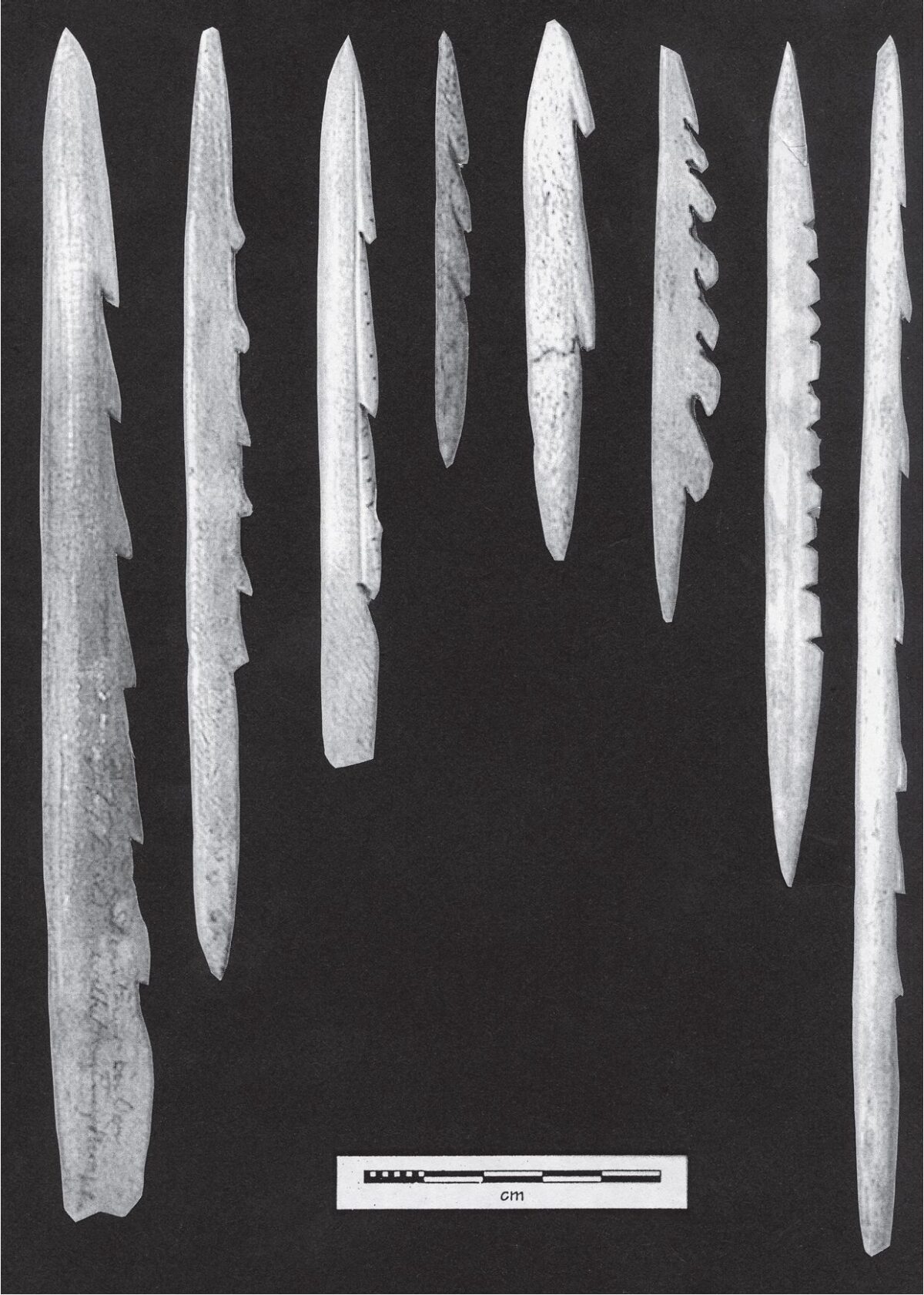Originally published in Projectile Point Sequences in Northwestern North America, 79-86.
2008.
By Grant Keddie
Introduction
Although projectile points can only be fully understood in the larger context of all forms of projectile heads, this chapter will focus on chipped stone points. Unfortunately the lack of enough detailed radiocarbon sequences that include sufficient samples of complete stone projectile points are lacking. Some of the information presented here must of necessity be based on before and after dates. Projectile points of a variety of types are found among the buried cultural debris in First Nations sites on southern Vancouver Island. These include the arming points for spears, harpoons and arrows. Spears with fixed point(s) include types that can be hand-throw, or spears that are thrown with the assistance of a throwing board (atlatl). Harpoons are a specialized kind of spear with barbed or toggle points that detach when the weapon is thrown or jabbed. The points may be made of wood, bone, antler, shell or stone. On a composite toggling harpoon the piercing point is usually set into antler or bone valves. Arrow points can be made of wood, stone, mussel shell and single or multiple bone points—usually with barbs (Figure 1). It is assumed that large barbed harpoons and the largest varieties of toggling harpoons would be primarily used for hunting larger sea mammals. Small barbed harpoons could be used for beaver and land otter, and the smallest toggling harpoons, especially those with round bone points—would be used for fish. Larger stone points may have been used mainly as fixed points on spears for hunting large land mammals or lances for finishing off harpooned sea mammals. Small stone points are generally assumed to have been arrow points. Several of the above types could also have been used in warfare.
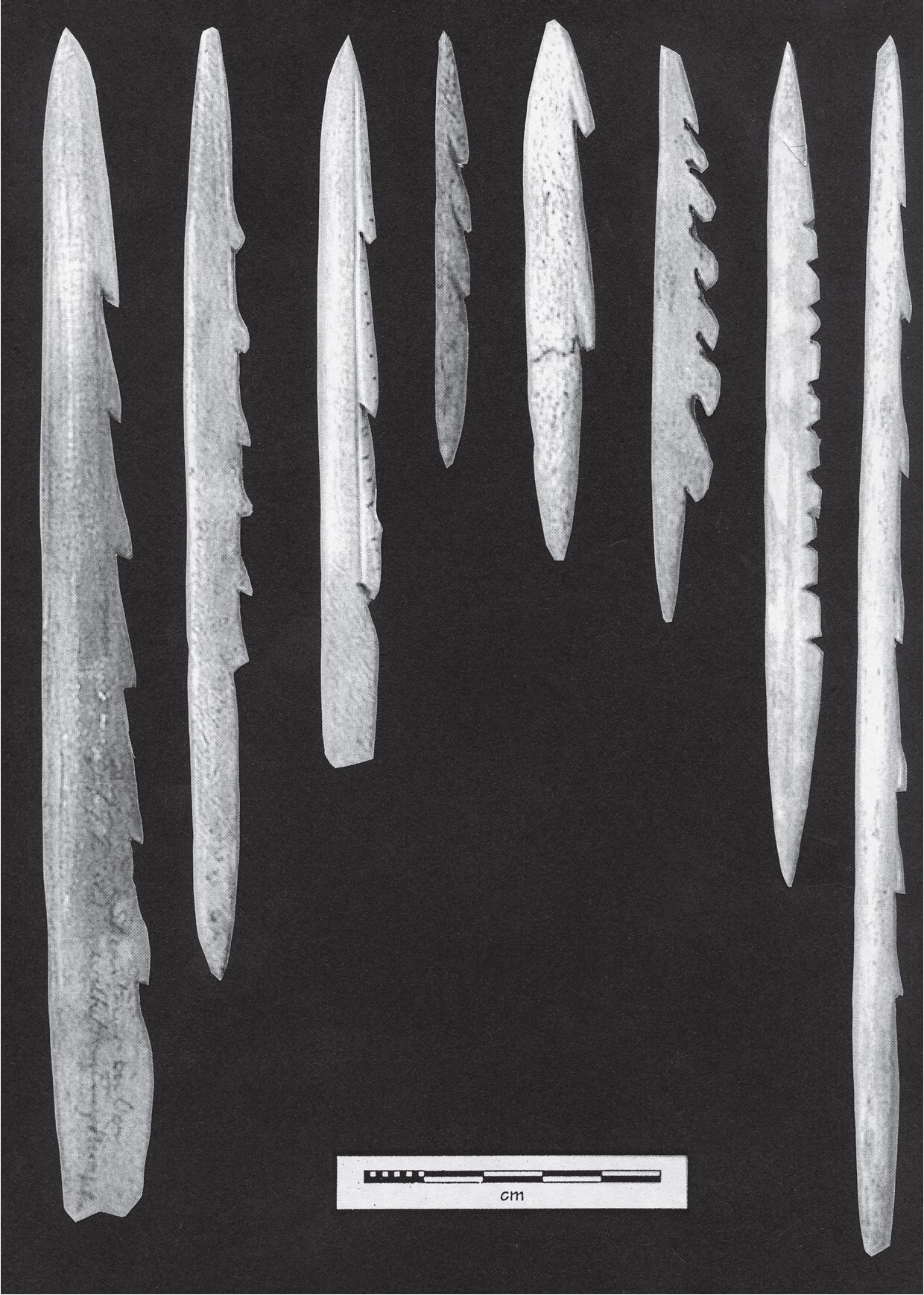
Form, Function and the Ethnographic Record
Assumptions are often made about the function of particular projectile point types without a sufficient database of research to backup the identifications. Telling the difference between stone points used for fixed spears, harpoons and knives can be difficult, as can distinguishing the difference between the small to medium size throwing spear dart heads and arrow points. ‘There is more certainty in ascribing function to some later period projectile samples due to the know historic use of similar artifact types, but even so, detailed ethnographic comparisons—especially with well documented museum collections—are few. Real arrows or spears that have actually been used with points of traditional style materials are rare in museum collections. Most arrows in the Royal British Columbia Museum collection are late 19th and early 20th century examples with iron points; only one arrow with a stone point and a few with bone points are not models made for collectors or anthropologists. The models made by First Nation individuals usually have points that do not accurately match older traditional styles. I will present a sequence of types here that should be considered preliminary until further controlled excavations produce larger samples of points from well-dated contexts.
Raw Materials and Technology
Factors affecting the nature of pre-contact projectile points include both access to different types of raw materials and ease of manufacture. The quality and size of raw materials would limit the kinds of points that could be produced. Trade in both raw materials and finished points had a definite effect on point styles. The introduction of iron could have enhanced the role of bone and antler in the production of some types of projectile points and caused the elimination of other raw material types that were harder to obtain or work. Studies on the changes in proportions of ground slate and fine grained flaked stone point types to each other and to bone and antler point types have been lacking due to insufficient samples in similarly dated contexts. Fine grained flaked stone points and ground slate points seem to have been recovered in similar proportions from many sites dating within at least the last 3000 years on southern Vancouver Island. This is true of both coastal shoreline and inland sites. Most flaked stone points are made of igneous rocks in the andesite/ba- salt/dacite continuum, although chert seems to be increasingly more common in later time periods. My use of the term chert includes all sedimentary rocks composed primarily of microcrystalline quartz, and includes chalcedony, agate, and jasper. Although in many sites only small numbers of projectile points have been systematically excavated in a datable context, a number of these sites such as DcRt-9 and DcRt-15, have hundreds of points with a site context, thus allowing us to substantiate whether the types and proportions of stone points in the scientific sample are representative of what is found in the larger site.
Projectile Points 3000 to 5000 BP
Only a few projectile points have been recovered from archaeological sites on southern Vancouver Island radiocarbon dated to over 3000 years. In this period there are many flaked stone points that have straight to excurvate sides on leaf shaped bodies. The halting element is often a well made triangular shape with a pointed or rounded base and a slight inset shoulder.
There is often a fine line between a stemmed projectile point and an unstemmed biface. The base of the hafting area may be rounded or taper to a point. These points are of various sizes, but commonly range from 3 cm to 8 cm. Rhomboidal and irregular points are not uncommon. A small number of the tapering stem types have moderately (as opposed to deep) serrated edges. At inland sites the latter are usually associated with ground slate points of a similar size or larger. These earlier slate points have thick beveled edges or are long and hexagonal in shape.
Examples of flaked stone points of this period can be seen in Figure 2, which includes all the points from a single component site, DiSe-10, that dates to 3500 BP (Riddl-576). This site on Denman Island is known as the Blufftop site (Eldridge 1987). Similar points can be seen in the earliest component at Duke Point, DgRx-5, near Nanaimo (Murray 1982). Murray’s marine calibrated shell dates were based on calculations that have now been superceded (see Deo et al. 2004). The actual age of the lower component I points shown in her figure 15, have a time more in the range of 4700 BP to 2700 BP This re-dating was confirmed by a subsequent date of about 3500 BP (S-2350) obtained by Cybulski (1990). Murray’s component II would also be older than the published sequence and date to around 2950 to 2250 BP. The latter component II has two leaf shaped, two tapering stemmed and two straight stemmed points.

Projectile Points 2900 to 2000 BP
Points found in the previous period are also found in this period but in very small numbers. There appear to be inter-regional differences in the percentage of stone point types found on southern Vancouver Island. The Maplebank site, DcRu-12, in Esquimalt harbour has two distinct portions of the midden separated by a 600 year hiatus (Keddie 1976). The upper Zone A may also have a temporal hiatus, but this is not as clearly defined as the separation between the upper Zones A-B with that of the lower Zone C. Zone A dates to a period from at least 600 BP (WSU 1583), to about 170 BP (WSU1539). Zone B, with six radiocarbon dates is concentrated in the period between 1460 BP (WSU 1586) and 1140 BP (WSU 1580). The distinct lower Zone covers the period from about 2900 BP (WAT 1616) to 2055 BP. (WSU 1584). All zones are dominated by triangular points in a range of sizes. The lower Zone C is dominated by triangular points with only a few leaf shaped bifaces, one diamond shaped stemmed point and one thin corner notched, chert point. Only a few of the 24 triangular points from Zone C are included in this image (Figure 3). What is significant at this site is the absence of assemblages from the time period from about 2000 BP to 1600 BP. This hiatus may account for the absence of stemmed and notched point types like those seen in large numbers at sites found only 6 to 7 km to the east.The small triangular points from DcRu-12 are of varying thickness and commonly range from 2 cm to 6 cm in length. They are the dominant type beginning around 2700 BP at the Maplebank site.
The Willows Beach site in Oak Bay, only 7 km to the east of the Maplebank site, also has distinct older and younger cultural components (Kenny 1974). The early Zone B is only found at the south end of the Willows Beach. The central and northern parts of the shell midden date to after about 1771 BP (SFU 792; shell date 2180 ± 70) and after 1483 BP (SFU 787, 1580 ± 70), (Keddie 1992).
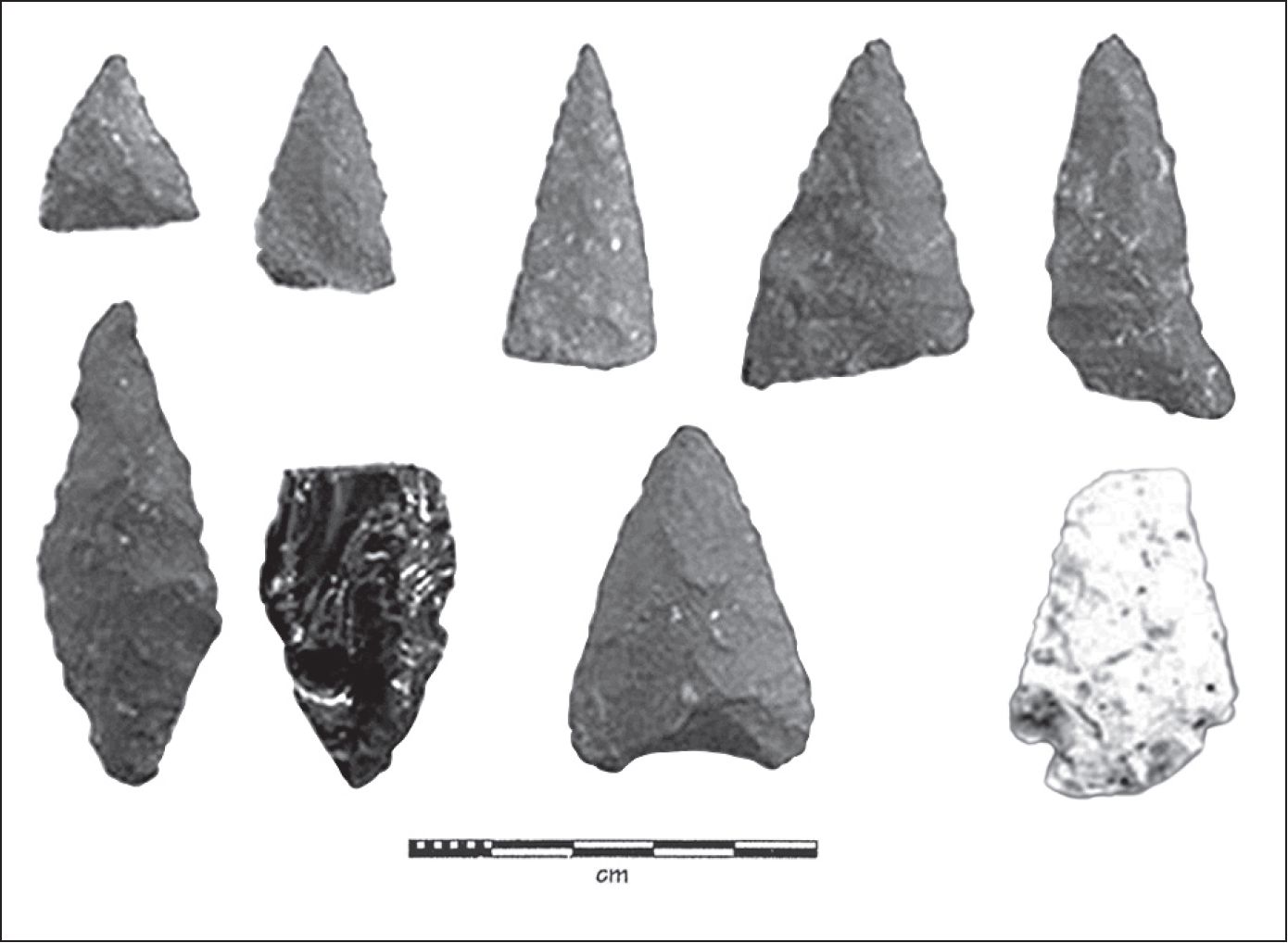
Kenny dated the lower deposits of the southern extreme of the site to a relatively short time period between 2630 ± 90 (Gak5102) and 2490 ± 85 BP (Gak5103). The lowest cultural unit II contained only one small leaf shaped and one small triangular point. Unit III above contained three corner indented points, a small triangular chert point, two leaf shaped bifaces and a unique excurvate edged obsidian point with a straight base (Figure 4). All upper Zone A points are triangular—although small stemmed unprovenienced points were found at the site.

The Bowker Creek site, DcRt-13, inland to the south of Willows Beach (Mitchell 1979), fits into a narrow time frame—dated by Mitchell to around 2910 ± 100 BP (Gak2760) to 2740 ± 100 BP (Gak2761). Mitchell gave a corrected average of the dates to 3018 ± 143 calendar years. However, these were shell dates, and new information (Deo et al. 2004) would suggest these shell dates should make the deposits about 400 years younger. A time frame of around 2510 BP to 2340 BP may be more accurate for these deposits. DcRt-13, has five different styles of flaked stone points (Figure 5). DcRt-13, like similar aged sites in the region, also has a range of slate points of which many are larger than the flaked stone points. Slate points are often reworked pieces of broken ones that were much larger in size. Fragmented pieces suggest that slate points in excess of 20 cm were not uncommon. A few complete examples have exceeded 40 cm in length (the size of a human forearm).
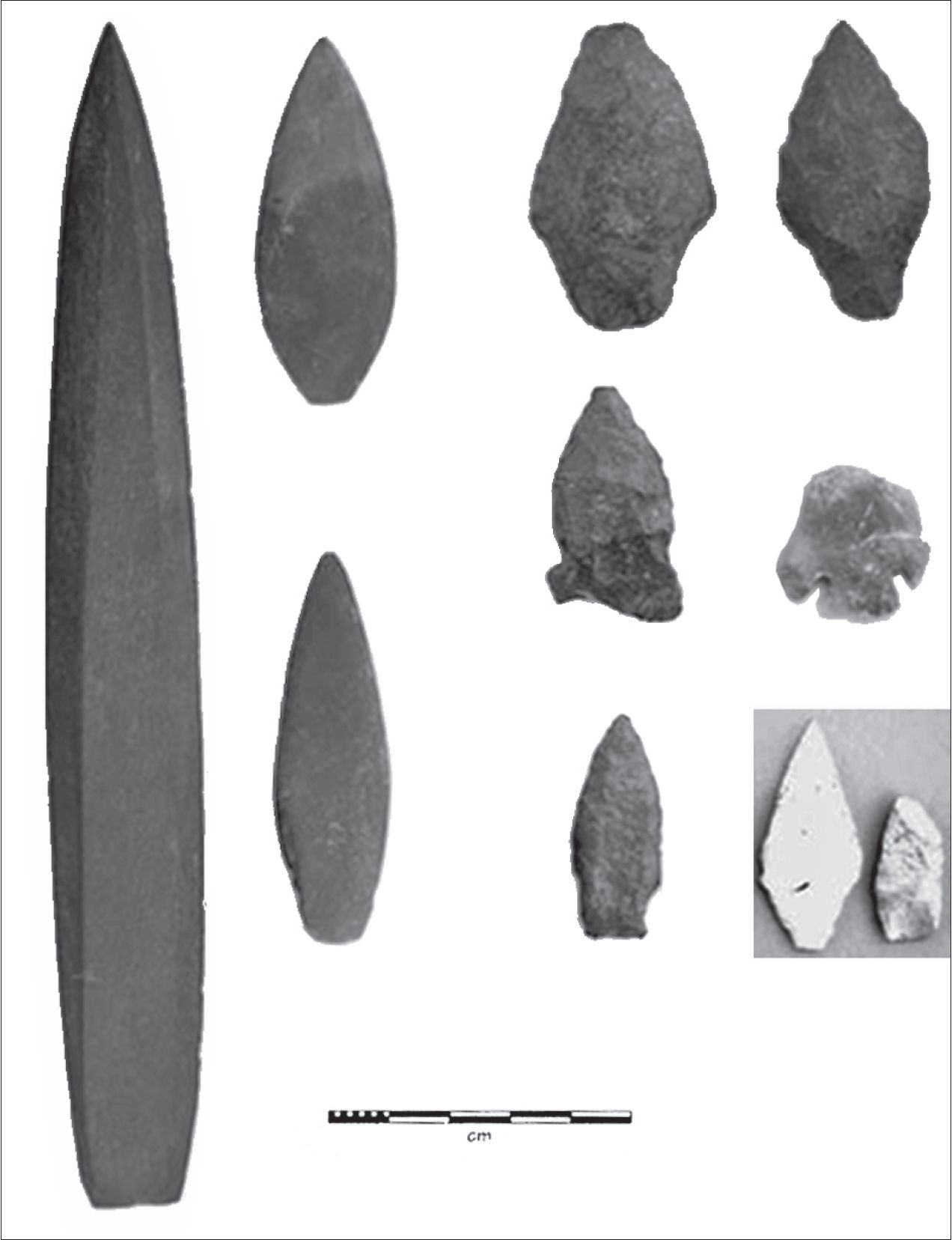
Small triangular points have not been found on the central part of Vancouver Island before about 1720 BP, the earlier possible date for the upper component III at the Duke Point site DgRx- 5, which contains four small triangular points, two small leaf shaped points, two small stemmed, one small corner notched and one small side notched points.
A different pattern occurs on the central east coast of Vancouver Island during the period from about 2050-1750 B.P., which is not well represented on the southern tip of the Island, the Departure Bay site, DhRx-16 near Nanaimo, is dominated by tapering stemmed points and a few side indented and corner notched points (Figure 6).

The small triangular stone points from Southern Vancouver Island appear to be arrow points and not harpoon points. If this is true, it would suggest that archery technology was introduced to this area by about 2700 BP—earlier than presently assumed. Evidence from other Pacific coast regions does not support or reject this idea. Similar triangular points are used in the arctic and south-eastern Siberia to Japan as cutting blades inset in harpoon points. Their use as harpoon points on Southern Vancouver Island may be ruled out because of the lack of slotted antler or bone points into which they would fit. Slotted wooden examples have not been found to date in waterlogged sites. These triangular points are consistently too thick to fit into the arming slot created by the two toggling valves of known harpoon points. These slots on the fitted valves found at this same time period are usually around 2 mm across, and only in the very large historic sea mammal harpoons is the rare one up to 5 mm thick, and even the slots on these are too narrow for most triangular flaked stone points.
On the Oregon coast researchers have correctly suggested that harpoon value lengths are crucial in determining species of prey hunted but have not recognized the importance of the width of the arming slot in determining the nature of the blade to be used. Clark (1991: 201) suggests that triangular points 2 cm wide or greater are points used to arm large composite harpoons for sea mammal hunting. This width measurement cuts through the normal range for Vancouver Island triangular points and makes no difference in terms of point thickness.
In Japan, where triangular arrow points go back before 9000 years ago, most are much smaller than the triangular points of southern Vancouver Island. The majority of Japanese points weigh less than one gram and few are over 3 grams (see Ikawa Smith 1998). Victoria region triangular points are mostly over 3 grams in weight with less than 20% being between 3 grams and 1.8 grams. Small Japanese stemmed points that are assumed to be spear points overlap in range with Vancouver Island triangular points, but on the average are 30% larger (5 gm vs. 3.5 gm). Judging what is an arrowhead and spearhead is difficult without making comparisons with the size and weight of the arrow and spear shafts (see Keddie and Nelson 2005). We need to consider that most of the small triangular points were harpoon points used with perishable wooden shafts. Most arrows may have been armed with hardwood and bone points, with very few being made from stone.
Another variation in point styles occurs in specialized points dating to the period around 2200 to 1800 years ago. These flaked stone points are medium to large finely flaked points of exotic materials that are mostly, if not exclusively, associated with burials. The raw materials, such as white chalcedony, are usually of obvious northwestern United States origin. It may be that these unique points were seen as wealth objects and intended to be used primarily as burial goods.
Projectile Points 1800 BP to 1140 BP
This period shows an increasing diversity of point styles but with local differences in dominate types. Small triangular points dominate the deposits at DcRu-12 in Esquimalt, but are found with large numbers of stemmed points at sites to the east, such as DcRt-8, DcRt-9 and DcRt-15 in Cadboro Bay. In addition to large numbers of triangular points, these sites have many small stemmed points and wide corner indented points (Figure 7). The latter point types are not associated with specific dates but seem to occur in a restricted time range. DcRt- 7, a shallow midden at Telegraph Cove, only 2 km east of Cadboro Bay, has large numbers of undated corner indented and stemmed points, but unlike at the other sites they far outnumber the triangular types. A few dated examples from other local sites and their absence at similar missing time periods at other sites such as DcRu-12, would indicate that the examples shown in Figure 7 most likely occur in the time period from 1800 to 1600 BP.

Regional differences can clearly be seen at DcRv-1 in Pedder Bay to the west of Victoria (Figure 8). This site, occupied in 1790, dates to after about 1600 BP (Gak1484), and lacks the microblade technology sometimes associated with larger stemmed and corner indented points in Marpole period assemblages. Here the assemblage is dominated by thinner stemmed points and—like other sites in the Sooke area west of Victoria—smaller triangular points that tend to have more concave bases.
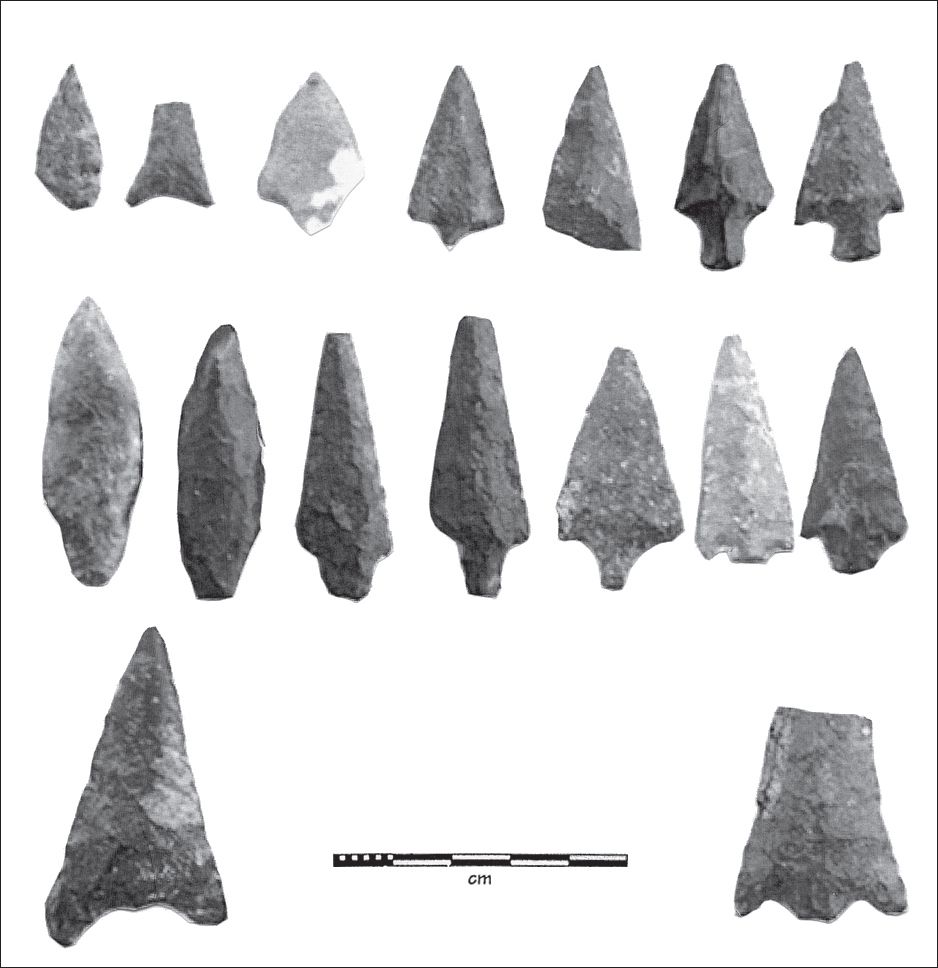
Projectile Points 900 BP to 600 BP
Triangular points dominate this time period at large sites such as DcRu-12 in Esquimalt harbour (Figure 9) and most other sites extending from the Oak Bay area and along the east coast of the Saanich Peninsula to the Basan Bay site, DdRu-4, south of Sidney. Some sites have proportionally smaller numbers with an increase in a range of projectile points made of exotic trade materials with basal, corner indented and corner and (rarely) side notching. Some of these are very small. There are similar points dating to the same time period in Washington and Oregon to the south. These point types tend not to be found in sites dating to the last 500 years. It may, therefore, be suggested that they are most common in the 900 BP to 600 BP time range.
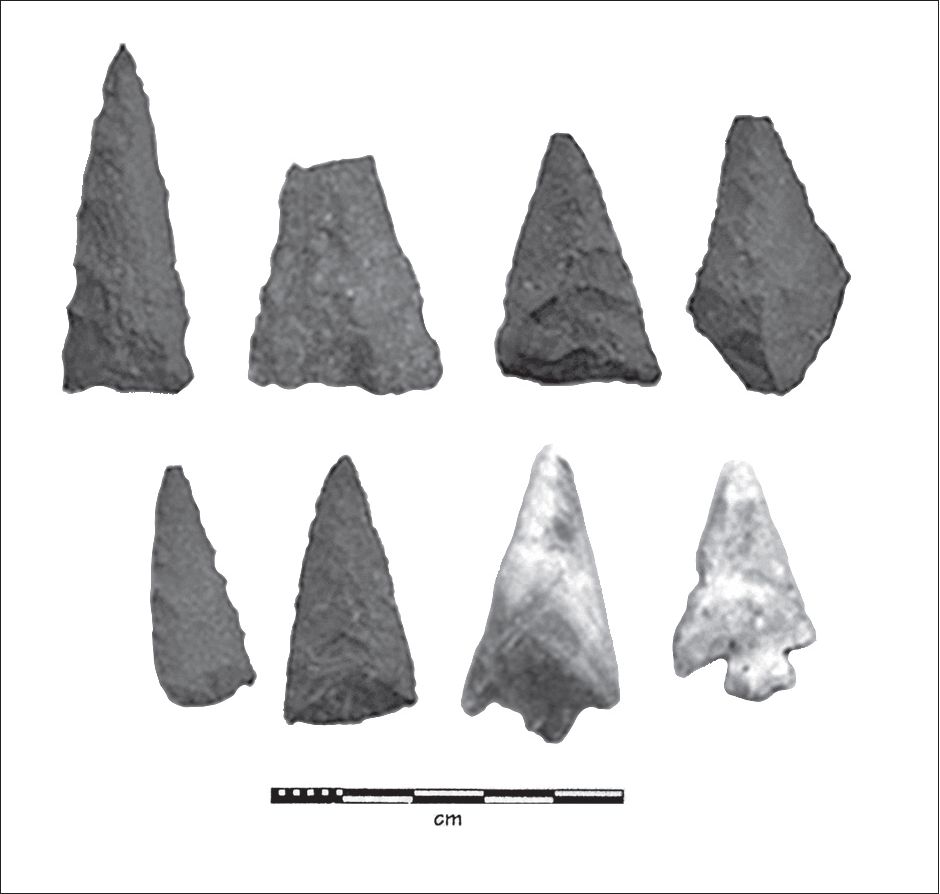
Small thin triangular slate and thin flat shell and bone points are common at some post 1000 year old sites. Unlike the triangular flaked stone points, the flat slate, shell and bone points are mostly close to 2 mm thick and best suited for arming points placed in the slot formed by two antler or sea mammal bone toggling harpoon valves. A small number of these slate points with basal barbs may also have been used as arrow points.
In the last 500 years stone projectile points are rare. There are several archaeological sites in the Victoria area with basal dates around 500 years old in which every stone projectile point at the site is different from the others. These same deposits show evidence throughout the deposits of the extensive use of iron tools for working a wide variety of bone tools. I have observed numerous examples of cut marks on bone points that can only be made by iron burins and iron rasp files.
Conclusions
There is a general presence of leaf shaped, short diamond shaped, and medium size leaf shaped stone projectile points with slight inset tapering stems on southern Vancouver Island in the period from about 5000 to 3000 BP. Small numbers of stemmed types occur that have more pronounced but rounded shoulders. Local stylistic differences can be seen, but can not be well defined without further field research.
The timing at which new types are introduced is different in parts of the region. Small numbers of triangular points appear by at least 2700 BP on the southern tip of the Island and dominate most assemblages after 1500 BP. They have not yet been shown to occur until after about 1700 BP further north on the Island and even then they only occur in small numbers. By 2700 BP small numbers of corner notched, corner indented and rare larger side notched points appear along the east coast of the Island.
Large exotic points were being imported and placed with burials on the east coast of the Island for at least a few hundred years centered on 2100 BP. The least known period is around 2000 to 1600 BP. Large numbers of poorly dated wide corner notched and corner indented points, as well as small to medium size stemmed points seem to occur mostly in part of this period from 1800 to 1600 BP. After about 1700 BP small triangular points made of local igneous materials replace these types for the most part. Proportional differences in point styles occurred within the larger region. Triangular points maintained a strong presence in some large sites around the Victoria area. After about 900 BP, a greater diversity of point styles occurred throughout the larger region. Many of these later points are made of exotic raw materials, and because of the lack of exotic waste material in local sites we must assume that these projectile points were traded as complete points from further south, although warfare cannot be ruled out as the cause of the appearance of some of them in this region.
Stone projectile points are rare by about 500 years ago. The use of iron gravers and rasp files for cutting and grinding bone, antler, hard wood and slate seems to have had a considerable impact on the nature of bone and antler projectile point production since at least the 16th century and probably much earlier. This iron was likely coming from long distant trade around the Pacific Rim as well as from shipwrecks, in the period before introduction by European traders.
References Cited
Cybulski, J. 1990. Human Biology. In: Handbook of North American Indians, Northwest Coast, Vol. 7, p. 57, Smithsonian Institution, Washington D.C.
Deo, J., J. Stone, and J. Stein. 2004. Building Confidence in Shell Variations in the Marine Radiocarbon Reservoir Correction for the Northwest Coast Over the Past 3,000 Years. American Antiquity 69(4):771-786.
Eldridge, M. 1987. Mitigation Excavation at DiSe 10, Denman Island, B.C.: Rockshelters and Blufftop Hunting Magic. Permit 1986-13. Prepared for the Heritage Conservation Branch. Ministry of Tourism, Recreation and Culture, Feb. 20, 1987. Eldridge Heritage Consulting.
Keddie, G., and D.E. Nelson. 2005. An Arrow from the Tsitsutl Glacier, British Columbia. Canadian Journal of Archaeology 29(1):113-123.
Keddie, G. 1992 Cultural Change in the Gulf of Georgia. Asking the Right Questions. The Midden 24(3):3-4.
Keddie, G. 1976 Preliminary report on the 1976 Maplebank Project excavations at DcRu 12. Heritage Conservation Branch, Permit #1976-18, pp. 1-13.
Kenny, R. 1974. Archaeological Investigations at the Willows Beach Site, Southeastern Vancouver Island. M.A. thesis, University of Calgary, Calgary.
Ikawa-Smith, F. 1998. Late Pleistocene and Early Holocene Technologies. In Windows on the Japanese Past Studies in Archaeology and Prehistory, R.J. Pearson, G.L. Barnes, and K.L. Hutterer (eds.). University of Michigan, Ann Arbor.
Mitchell, D. 1979. Bowker Creek: A Microblade Site on Southeastern Vancouver Island. Syesis 12:77-100.
Murray, R. 1982. Analysis of Artifacts from the Duke Point Area Sites, Near Nanaimo, B.C.: An Example of Cultural Continuity in the Southern Gulf of Georgia Region. Mercury Series, National Museum of Man, Archaeological Survey of Canada Paper No. 113, Ottawa.
